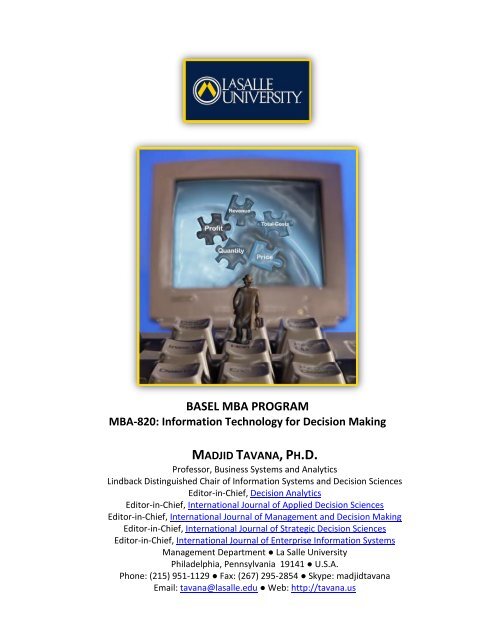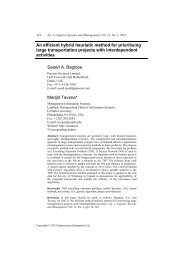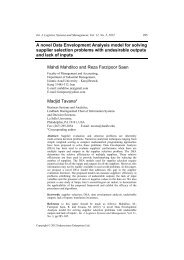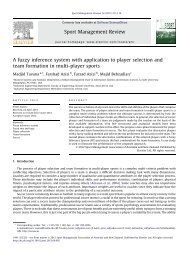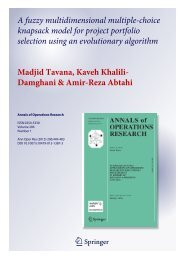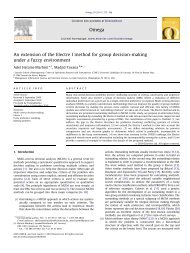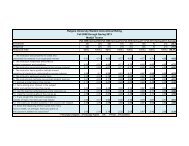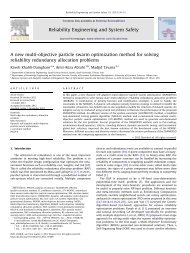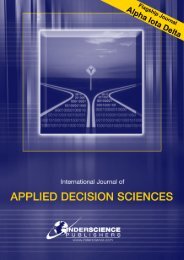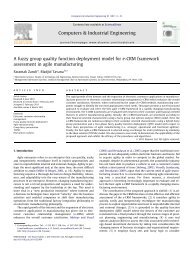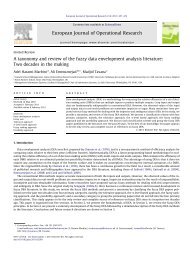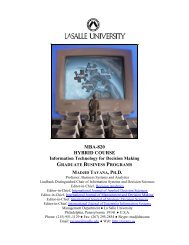Basel MBA-820 Course Syllabus - Dr. Madjid Tavana, Professor of ...
Basel MBA-820 Course Syllabus - Dr. Madjid Tavana, Professor of ...
Basel MBA-820 Course Syllabus - Dr. Madjid Tavana, Professor of ...
- No tags were found...
Create successful ePaper yourself
Turn your PDF publications into a flip-book with our unique Google optimized e-Paper software.
BASEL <strong>MBA</strong> PROGRAM<strong>MBA</strong>-<strong>820</strong>: Information Technology for Decision MakingMADJID TAVANA, PH.D.<strong>Pr<strong>of</strong>essor</strong>, Business Systems and AnalyticsLindback Distinguished Chair <strong>of</strong> Information Systems and Decision SciencesEditor-in-Chief, Decision AnalyticsEditor-in-Chief, International Journal <strong>of</strong> Applied Decision SciencesEditor-in-Chief, International Journal <strong>of</strong> Management and Decision MakingEditor-in-Chief, International Journal <strong>of</strong> Strategic Decision SciencesEditor-in-Chief, International Journal <strong>of</strong> Enterprise Information SystemsManagement Department ● La Salle UniversityPhiladelphia, Pennsylvania 19141 ● U.S.A.Phone: (215) 951-1129 ● Fax: (267) 295-2854 ● Skype: madjidtavanaEmail: tavana@lasalle.edu ● Web: http://tavana.us
Walker et al. J Clin Path. April 2008).Her2 status is tested using immunohistochemistry (IHC) followed by FISH analysis <strong>of</strong> borderline2+ cases. If there is insufficient or sparse sampling <strong>of</strong> tumour in the core biopsy specimen theHer2 test is carried out on the surgical resection specimen.All specimens for Her2 testing to Source Bioscience. Their laboratory is CPA accredited andparticipates in the UK NEQAS scheme for Her2 IHC and FISH testing.Percentage <strong>of</strong> women <strong>of</strong>fered access to immediate reconstruction surgery by MDT or by referralonto another team and rate <strong>of</strong> uptakeThe majority <strong>of</strong> patients who have a mastectomy are <strong>of</strong>fered reconstructive surgery. Exceptionsto this would be patients who are infirm or frail or who have other medical problems that wouldprevent them from undergoing this type <strong>of</strong> surgery. 22 patients had immediate reconstruction atColchester General Hospital (20 implant only, 0 LD flap only, 2 LD flap plus implant). No figurescan be given for the number <strong>of</strong> reconstructive operations, whether joint procedures, immediateor delayed for Broomfield Hospital (despite requests being submitted).22 patients represents 20% <strong>of</strong> the total number <strong>of</strong> mastectomies which is in line with dataoutlined in the National Mastectomy and Reconstruction Report 2011. This figure will beincreased if taking into account the reconstructions done at Broomfield Hospital.Ratio <strong>of</strong> mastectomy to breast conserving surgeryBased on local data, 110 patients had mastectomy. 233 patients had breast conserving surgery.30 day post operative mortality rate= 0%.One, two and five year survival ratesThis data is not available at Trust level, only PCT or Network level. Information has proveddifficult to obtain. The following is a copy <strong>of</strong> data provided by the National Cancer IntelligenceNetwork relating to one and five year survival rates.2002/03 Cohort 2007 CohortPresentation Route 1-year relative survival(LCI-UCI) 5-year relative survival(LCI-UCI) 1-year relative survival(LCI-UCI)Screen-detected 100% (99.8% - 100.2%) 97.1% (96.5% - 97.6%) 100.2% (100.1% - 100.4%)Symptomatic 92.8% (92.4% - 93.1%) 76.8% (76.2% - 77.4%) 94% (93.6% - 94.3%)All cases 94.3% (94.1% - 94.6%) 81.3% (80.8%-81.8%) 95.8% (95.6%-96.0%)1-year and 5-year relative survival rates with presentation routes for women diagnosed withinvasive/micro-invasive breast cancer in 2002/2003 and 2007 (LCI = 95% lover confidenceinterval; UCI = 95% upper confidence interval).Each surgeon managing at least 30 new cases per year & Average length <strong>of</strong> stay for breastcancer with any surgical procedureIntended Management LOS Grand TotalDaycase 0 1041 4` 3 1Daycase Total 109SELF ASSESSMENT REPORT for Colchester Hospital University NHS Foundation Trust - Breast MDT (published: 30th September 2011) Page: 3/6
operations department can use this information in a DSS to assess pr<strong>of</strong>itability. The financedepartment can synthesize this information in a KBS and make expansion or contractiondecisions.This course focuses on data, information, and knowledge by utilizing a series <strong>of</strong> tools to developDatabase Management Systems, Management Information Systems, Decision Support Systems,and expert System in support <strong>of</strong> the decision making and problem solving processes in a handsonenvironment.5. WEB RESOURCES:http://tavana.us/downloads/downloads.shtmlusername: tavanapassword: spacewalk6. COURSE TOPICS AND REQUIREMENTS:The World <strong>of</strong> Information Systems and Decision SciencesDecision Making in the Information AgeTransactional Processing Systems and Database ManagementDatabase Management Systems (SA-DBM-H)Building DBMS with ACCESS (SA-ACC-H)Cases:Happyville Casino, Explorer Healthcare, Great Times Summer Camp, and Jimmy “the BodyBag” Biggs4
Access Case Analysis OR Access Problem in Exam (15% <strong>of</strong> the Final Grade):Access Case Report: A PowerPoint Presentation with Problem Description, InitialTable, Split Tables, Relationships, and Query.SAMPLE ACCESS CASE & DATABASE.Decision Support Systems and SpreadsheetsDecision Support Systems and EXCEL (DS-EXL-H)Cases:American Appliances, Heinrich Company, Francois Stealth, Planters Nut Company, TitanicCruise Company, Built-4-U, Golden Palace Casino, Impulse Shopping Network, and Rent-A-Wreck.Excel Case Analysis OR Excel Problem in Exam (15% <strong>of</strong> the Final Grade):Excel Case Report: A PowerPoint Presentation with Problem Description, ExcelSpreadsheet, Solver Formulation, and Optimal Solution.SAMPLE EXCEL CASE & EXCEL FILE.Decision Support Systems and Natural Language Programming (Visit D-code.us)Natural Language Programming: D-code (DS-COL-H)Building DSS with D-code (DS-COP-H)Cases:Keystone Corporation, Prolog Corporation, Starship Technologies, <strong>Dr</strong>. Warped, and Jungle JimD-code Case Analysis OR D-code Problem in Exam (15% <strong>of</strong> the Final Grade):D-code Case Report: A PowerPoint Presentation with Problem Description,Influence Diagram, Planners Lab Model, and Spreadsheet Solution.SAMPLE D-CODE CASE & D-code FILE.Decision Support Systems and Influence Diagramming (Visit D-cide.us)Influence Diagramming and D-cide (DS-DCD-H)Cases:5
Procom Corporation, Thrills R Us, Parrot Club, Southwest Airline, Pick Your Own, Jungle JimD-cide Case Analysis OR D-code Problem in Exam (15% <strong>of</strong> the Final Grade):D-code Case report: A PowerPoint Presentation with Problem Description,Influence Diagram Screenshot, and Spreadsheet Solution.SAMPLE D-cide CASE & D-cide FILE.Knowledge-Based Systems (Visit B-wise.us)Knowledge Engineering with B-wise (DS-BWL-H)Building Expert Systems with B-wise (DS-BWP-H)Cases:Check Cashing Problem, College Hill Tavern, Police Academy, Corleone Family, La Boutique,and Gateway ComputersB-wise Case Analysis OR B-wise Problem in Exam (15% <strong>of</strong> the Final Grade):B-wise Case Report: A PowerPoint Presentation with Problem Description, Alisting <strong>of</strong> Factors and Choices, and Decision Tree Screenshot.SAMPLE B-wise CASE & B-wise FILE.Exam (Between 0% to 25% <strong>of</strong> the Final Grade)A hands-on exam focusing on the systems described throughout thecourse (Open Book and Open Notes).Pr<strong>of</strong>essionalism (5% <strong>of</strong> the Final Grade)7. PROFESSIONALISM:The majority <strong>of</strong> this class is engaged in full time employment or is seeking to enhance theiremployment opportunities. I would like to help you enhance your career by asking you to behaveas you would in a pr<strong>of</strong>essional setting. To do this, I suggest that you think <strong>of</strong> me as your manager,and our class sessions as regularly scheduled meetings. Following are some <strong>of</strong> the things thatpr<strong>of</strong>essionals would never do:Miss a regularly scheduled meeting.6
Arrive late for a meeting without explaining the circumstances ahead <strong>of</strong> time.Leave early from a meeting, without explaining the circumstances ahead <strong>of</strong> time.Sleeping or being inattentive during a meeting.Being unprepared or being unwilling to participate in class and group discussions.To encourage development <strong>of</strong> pr<strong>of</strong>essional habits, there will be a penalty <strong>of</strong> 10 points (out <strong>of</strong>100) for each class missed unless an excuse (not exceeding one class) is obtained from theinstructor IN ADVANCE <strong>of</strong> the class.8. CUSTOMIZING YOUR COURSE REQUIREMENTS:You can choose to show your pr<strong>of</strong>iciency in each course topic through a case study or examproblem. A minimum <strong>of</strong> two case studies is required from each student to partially satisfy thisrequirement:9. GRADING POLICY:<strong>Course</strong>ComponentCase Study ExamAccess 15% OR 15%Excel 15% OR 15%D-code 15% OR 15%D-cide 15% OR 15%B-wise 15% OR 15%Group Project 25%Total 100%Cases should be submitted through the following online submission system:7
Grades are sent to each student through email using the following evaluation form:Grading Criteria 0 1 2 3 4 5 6 7 8 9 10Originality/CreativityPresentationProblem DescriptionComplexitySolutionOverall scoreThe student earns points which will be calculated on a 100 point scale. There is no extra credit.The following are the cut<strong>of</strong>f points for each grade:A Indicates the demonstration <strong>of</strong> a superior level <strong>of</strong> competency 93.0-100A- Indicates the demonstration <strong>of</strong> a very good level <strong>of</strong> competence 90.0-92.9B+ Indicates the demonstration <strong>of</strong> a good level <strong>of</strong> competency 87.0-89.9B Indicates the demonstration <strong>of</strong> an average, satisfactory level <strong>of</strong> competency 83.0-86.9B- Indicates the demonstration <strong>of</strong> a less than average level <strong>of</strong> competency 80.0-82.9C Indicates a below average and marginally satisfactory level <strong>of</strong> competency 70.0-79.9F Indicates failure to demonstrate a satisfactory level <strong>of</strong> competency 00.0-69.9La Salle University is a community <strong>of</strong> shared academic values, foremost <strong>of</strong> which is a strongcommitment to intellectual honesty, honorable conduct, and respect for others. In order to meetthese values, students are expected to adhere to the highest standards <strong>of</strong> academic integrity.These standards are embodied in the La Salle University Academic Integrity Policy and areavailable online at: http://tavana.us/AIP.pdf11. GROUP PROJECT:Big Data and Decision AnalyticsBANKING IN EMERGING ECONOMIESThe determinants for the internationalization <strong>of</strong> banking are based on country characteristics and marketdynamics and bank-specific advantages. Primarily the country characteristics consist <strong>of</strong> barriers to entry8
to provide services, the type <strong>of</strong> activities allowed and the type <strong>of</strong> investment allowed, as well as,regulations on capital flows and taxation and repatriation <strong>of</strong> pr<strong>of</strong>its, or indeed, tax benefits <strong>of</strong>fered by agovernment to attract foreign banks to invest directly to encourage spill-over effects in the industry. Thesize <strong>of</strong> the market for banking products and specifically the product markets that are targeted and thepotential growth <strong>of</strong> these are other factors. In terms <strong>of</strong> the foreign financial market dynamics the potentialperformance and pr<strong>of</strong>itability depends on the interaction and rivalry among existing banks in the market,the number <strong>of</strong> these their nationality and their size distribution, that is whether it a concentratedoligopolistic market with a few large banks and some other smaller banks, or it is a highly fragmentedmarket. Different product markets and customer segments, that is, individual or corporate customers,may have different levels <strong>of</strong> rivalry and margins and hence pr<strong>of</strong>itability is different for each type. The morea bank has distinctive competencies the more that they may be transferred abroad. By definition whenthey have distinctive there must be some competitive advantage for the bank.The decision to enter an emerging economy by a multinational bank is a very important one, as manyfactors need to be considered. We consider the following 30 countries in 4 continents: Africa (Angola,Ghana, Kenya, Namibia, Nigeria, South Africa, Uganda); Asia (Taiwan, Thailand, South Korea, Vietnam);Europe (Bulgaria, Czech Republic, Estonia, Hungary, Latvia, Lithuania, Poland, Romania, Slovakia, Slovenia,Turkey, Ukraine); and Latin America (Argentina, Brazil, Chile, Colombia, Ecuador, Mexico, Uruguay).PESTEL analysis (political, economic, social, technological, environmental, and legal analysis) is used toinitially collect 500 factors grouped into the political, economic, social, technological, environmental, andlegal categories. We then use FONDA to Filter, Organize, Normalize, Decide, and analyze the data. Aminimum <strong>of</strong> 200 factors for the abovementioned 30 countries must be used in the final data set. Moreinformation is available at: http://tavana.us/project/Click here to open and fill out your data sheet. Please return or email yourcompleted data sheet to your instructor during the first week <strong>of</strong> classes.9


